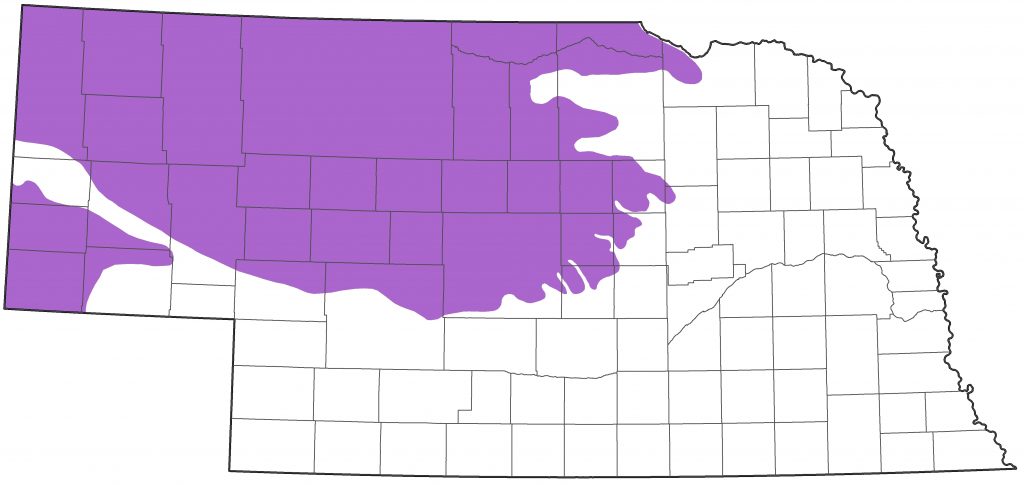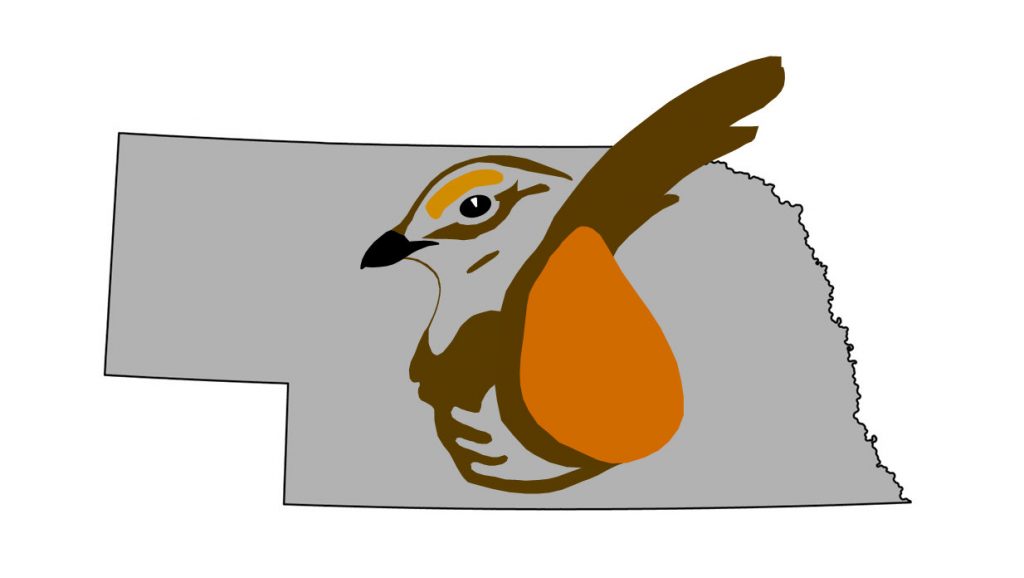Tympanuchus phasianellus jamesi
Status: Locally common regular resident north and west, rare casual elsewhere. Uncommon casual winter visitor south and east of breeding range.

Documentation: Specimen: UNSM ZM12561, 23 Feb 1896 Harrison, Sioux Co.
Taxonomy: Six subspecies plus extinct hueyi are recognized (Gill et al 2022); Connelly et al (2020) divided these into northern and southern groups. The paler southern group consists of hueyi of New Mexico, now extinct, columbianus of the Great Basin, and jamesi of the Great Plains.
We follow Connelly et al (2020); Nebraska birds are jamesi.
Hybrids with Greater Prairie-Chicken (T. cupido) are well-known (Mathisen and Mathisen 1959). See Sharp-tailed Grouse x Greater Prairie-Chicken.
Changes since 2000: Reports from Kimball and Banner Cos are increasing; this is the only area south of the North Platte and Platte river valleys where the species occurs regularly.
Resident: Sharp-tailed Grouse was the dominant grouse species in Nebraska some 200 years ago, but settlement and its associated agricultural practices eliminated the species from much of eastern and southern Nebraska (King et al 2018, Sisson 1976). Greater Prairie-Chicken subsequently occupied much of the area abandoned by Sharp-tailed Grouse; both species continue to coexist in much of central Nebraska (Berger et al 2023). All counties north of the North Platte and Platte rivers are occupied except for the northeast. Perhaps highest numbers occur in Cherry Co (Berger et al 2023); large numbers occur in the Kilgore area (Tom Schneider, eBird.org).
Ecological relationships between Greater Prairie-Chicken and Sharp-tailed Grouse in the Sandhills were discussed by Berger et al (2023). These authors stated that Greater Prairie-Chicken and Sharp-tailed Grouse “do not behave as a single species in the Sandhills” and Hiller et al (2019) noted that breeding habitat niches were different between the two species although habitat use was similar during the rest of the year and pointed out that shifts in habitat quality could provide an advantage to one or the other species. Berger et al (2023), building on these considerations, suggested that since the range of Sharp-tailed Grouse is at its southern extent in Nebraska, “it may not make sense to manage for sharptails in the Sandhills”, adding, however, that the importance of “rear edge” populations faced with changing climate may be underestimated due to their ecological adaptability. Such adaptability, if lost through anthropogenic disturbance, may “reduce the ability of species to persist in the face of rapid future climate change” (Rehm et al 2015).
A well-known part of the “rear edge” (Berger et al 2023) of the Nebraska Sharp-tailed Grouse range is the apparently relict population on the Taylor Ranch, an area of remnant Sandhills just northwest of Grand Island, Hall Co (Lingle 1994). This population was reliably observed in the late 1980s and 1990s (Lingle 1994) but appears to have declined since 2014 (Rick Rasmussen, personal communication). Three sharp-tails were there 27 Feb 2016 (Mark Brogie, eBird.org) and a hybrid was photographed there in 2018 (Colleen Childers, personal communication).
The regular range extends eastward in the north to northwestern Knox Co, where a “known lek” is about five miles north of Winnetoon; up to five were there 18 Ap-1 May 2024. One was five miles south of Creighton in Antelope Co in 2004. Easternmost records are of one at Buckskin Hills WMA, Dixon Co 9 Apr 2005, and another near Buckskin Hills WMA 7 May 2019. Southerly reports include two leks in 2006-2008 in north-central Dawson Co 2006-2008 and singles in southern Buffalo Co 25 Jul 2003, at Rowe Sanctuary 16 Aug 2018, and presumably the same individual was at a Greater Prairie-Chicken lek at Mormon Island, Hall Co 1 Apr-20 May 2015 and Apr 2017 (King et al 2018).
The only other reports south of the Platte River Valley and east of the Panhandle are of one at Hastings, Adams Co 2 May 1943 (Jorgensen 2012), one at Victor Lake WPA, Gosper Co 7 Jul 1994, and a “probable” breeding report in Dundy Co (Mollhoff 2016).
Sharp-tailed Grouse occurs in small but apparently increasing numbers in the Panhandle in Kimball and Banner Cos; 16 were seen in central Kimball Co 23 Sep 1995, 10 were there 25 Aug 2014, and 1-6 in Kimball and Banner Cos 29 Apr-23 May 2012. There were 20 in southwest Banner Co 12 Apr 1997 and eight there 18 Apr 2008.
Like Greater Prairie-Chicken, male Sharp-tailed Grouse gather on leks where they display communally in an effort to attract a mate. Although leks may be attended by males from late winter through spring, peak activity occurs during the hen visitation period mid-Apr to early May. Dancing grounds are usually broad hilltops of short grass, but large open valleys may be used in the Sandhills, particularly where hilltops are sharp, choppy, and unstable. A nesting study in the Western Sandhills indicated a nest density of one per 70 hectares (174 acres) (Blus and Walker 1966).
Observations made of a single male at a Greater Prairie-Chicken lek on Mormon Island, Hall County in 2015 and 2017 are of interest (King et al 2018). This bird may have come from the Taylor Ranch area in Hall Co, some 40 km from Mormon Island; Sisson (1976) detected a maximum range of movement for the species in his study of 53.6 km (King et al 2018). In 2015, this individual stayed on the outskirts of the Mormon Island prairie-chicken lek, possibly because it was a young bird, but in 2017 it had moved closer to the center of the lek (King et al 2018), a progression noted by Sisson (1976) for male Greater Prairie-Chickens presumably as they rise in dominance.
- Breeding Phenology:
Displaying males on lek: 13 Feb-19 Apr.
Eggs: 21 Apr- 6 Aug (Mollhoff 2022).
Dependent young: 8 Jun-11 Aug. - A study of radio-tagged hens at Crescent Lake NWR, Garden Co 2007-2008 found that as many as four nesting attempts were made by some hens without success (Huber; Mollhoff 2022).
- High counts: 40 at lek in Thomas Co 16 Apr 2023, and 40 at Niobrara Valley Preserve in Brown Co 7 Mar 2023.
Winter: This species is not as prone as Greater Prairie-Chicken to move southeastward of the breeding range in winter. There are few such reports: 26 Oct 1986 and 21 Dec 1987 in Polk Co, 3 Dec 1982 in Lancaster Co, and 12 Jan 1976 in Adams Co.
- High counts: 50 in Thomas Co 7 Sep 2015, 50 near Kilgore, Cherry Co 3 Feb 2021, and a flock of 44 near Broken Bow 2 Oct 2010.
Highest CBC totals are 129 at Calamus-Loup in 1994, 104 at North Platte in 1992, 54 at Greeley in 1969, and 53 at Crawford in 1979.
Acknowledgement
Jeffrey J. Lusk provided numerous helpful comments that improved this species account.
Literature Cited
Berger, D.J., J.J. Lusk, L.A. Powell, and J.P. Carroll. 2023. Exploring Old Data with New Tricks: Long-Term Monitoring Indicates Spatial and Temporal Changes in Populations of Sympatric Prairie Grouse in the Nebraska Sandhills. Diversity 15, 114. https://doi.org/10.3390/d15010114.
Blus, L.J., and J.A. Walker. 1966. Progress report on the Prairie Grouse nesting study in the Nebraska Sandhills. NBR 34: 23-30.
Connelly, J.W., M.W. Gratson, and K.P. Reese. 2020. Sharp-tailed Grouse (Tympanuchus phasianellus), version 1.0. In Birds of the World (A. F. Poole and F. B. Gill, Editors). Cornell Lab of Ornithology, Ithaca, NY, USA. https://doi.org/10.2173/bow.shtgro.01.
Gill, F., D. Donsker, and P. Rasmussen (Eds). 2022. IOC World Bird List (v 12.2). Doi 10.14344/IOC.ML.12.2. http://www.worldbirdnames.org/.
Hiller, T.L.; McFadden, J.E.; Powell, L.A.; Schacht, W.H. 2019. Seasonal and Interspecific Landscape Use of Sympatric Greater Prairie-Chickens and Plains Sharp-Tailed Grouse. Wildlife Society Bull. 43, 244–255.
Jorgensen, J.G. 2012. Birds of the Rainwater Basin, Nebraska. Nebraska Game and Parks Commission, Lincoln, Nebraska, USA.
King, K.C., A.J. Caven, and K. Geluso. 2018. Lekking behavior of a Sharp-tailed Grouse in south-central Nebraska. The Prairie Naturalist 50: 39-41.
Lingle, G.R. 1994. Birding Crane River: Nebraska’s Platte. Harrier Publishing Grand Island, Nebraska, USA.
Mathisen, J., and A. Mathisen. 1959. Sharp-tailed Grouse and Prairie Chickens. NBR 27: 28.
Mollhoff, W.J. 2016. The Second Nebraska Breeding Bird Atlas. Bull. Univ. Nebraska State Museum Vol 29. University of Nebraska State Museum, Lincoln, Nebraska, USA.
Mollhoff, W.J. 2022. Nest records of Nebraska birds. Nebraska Ornithologists’ Union Occasional Paper Number 9.
Rehm, E.M., Olivas, P., Stroud, J., and Feeley, K.J. 2015. Losing Your Edge: Climate Change and the Conservation Value of Range-Edge Populations. Ecological Evolution 5: 4315–4326.
Sisson, L. 1976. The sharp-tailed grouse in Nebraska. Nebraska Game and Parks Commission, Staff Research Publications No. 38, Lincoln, Nebraska, USA.
Recommended Citation
Silcock, W.R., and J.G. Jorgensen. 2024. Sharp-tailed Grouse (Tympanuchus phasianellus). In Birds of Nebraska — Online. www.BirdsofNebraska.org
Birds of Nebraska – Online
Updated 2 Jun 2024
